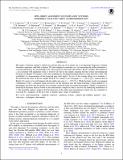SPIN–ORBIT ALIGNMENT OF EXOPLANET SYSTEMS: ENSEMBLE ANALYSIS USING ASTEROSEISMOLOGY
Author(s)
Campante, T. L.; Lund, M. N.; Kuszlewicz, J. S.; Davies, G. R.; Chaplin, W. J.; Albrecht, S.; Bedding, T. R.; Benomar, O.; Bossini, D.; Handberg, R.; Santos, A. R. G.; Basu, S.; Christensen-Dalsgaard, J.; Elsworth, Y. P.; Hekker, S.; Hirano, T.; Huber, D.; Karoff, C.; Kjeldsen, H.; Lundkvist, M. S.; North, T. S. H.; Silva Aguirre, V.; Stello, D.; White, T. R.; Winn, Joshua Nathan; Van Eylen, Vincent; ... Show more Show less
DownloadCampante-2016-SPIN-ORBIT ALIGNMENT.pdf (6.203Mb)
PUBLISHER_POLICY
Publisher Policy
Article is made available in accordance with the publisher's policy and may be subject to US copyright law. Please refer to the publisher's site for terms of use.
Terms of use
Metadata
Show full item recordAbstract
The angle ψ between a planet's orbital axis and the spin axis of its parent star is an important diagnostic of planet formation, migration, and tidal evolution. We seek empirical constraints on ψ by measuring the stellar inclination i[subscript s] via asteroseismology for an ensemble of 25 solar-type hosts observed with NASA's Kepler satellite. Our results for i[subscript s] are consistent with alignment at the 2σ level for all stars in the sample, meaning that the system surrounding the red-giant star Kepler-56 remains as the only unambiguous misaligned multiple-planet system detected to date. The availability of a measurement of the projected spin–orbit angle λ for two of the systems allows us to estimate ψ. We find that the orbit of the hot Jupiter HAT-P-7b is likely to be retrograde (ψ = 116[° over .]4[+30.2 over -14.7]), whereas that of Kepler-25c seems to be well aligned with the stellar spin axis (ψ = 12[° over .]6[+6.7 over -11.0]). While the latter result is in apparent contradiction with a statement made previously in the literature that the multi-transiting system Kepler-25 is misaligned, we show that the results are consistent, given the large associated uncertainties. Finally, we perform a hierarchical Bayesian analysis based on the asteroseismic sample in order to recover the underlying distribution of ψ. The ensemble analysis suggests that the directions of the stellar spin and planetary orbital axes are correlated, as conveyed by a tendency of the host stars to display large values of inclination.
Date issued
2016-03Department
Massachusetts Institute of Technology. Department of Physics; MIT Kavli Institute for Astrophysics and Space ResearchJournal
The Astrophysical Journal
Publisher
IOP Publishing
Citation
Campante, T. L., M. N. Lund, J. S. Kuszlewicz, G. R. Davies, W. J. Chaplin, S. Albrecht, J. N. Winn, et al. “SPIN–ORBIT ALIGNMENT OF EXOPLANET SYSTEMS: ENSEMBLE ANALYSIS USING ASTEROSEISMOLOGY.” The Astrophysical Journal 819, no. 1 (March 1, 2016): 85. © 2016 The American Astronomical Society
Version: Final published version
ISSN
1538-4357
0004-637X